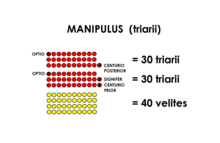Triarii
 |
| Part of a series on the |
| Military of ancient Rome |
|---|
|
|

Triarii (sg.: triarius) were one of the elements of the early Roman military
During the Camillan era, they fought in a shallow phalanx formation, supported by light troops. In most battles triarii were not used because the lighter troops usually defeated the enemy before the triarii were committed to the battle. They were meant to be used as a decisive force in the battle, thus prompting an old Roman saying: res ad triarios venit, 'it comes down to the triarii', which meant carrying on to the bitter end.[2]
History and deployment
According to author
Camillan era
By the 4th century BC, the military formations the Romans had inherited from the Etruscans were still in use. Though their efficiency was doubtful, they proved effective against Rome's largely local adversaries. When Gauls invaded Etruria in 390 BC, the inhabitants requested help from Rome. The small contingent Rome sent to repel the Gallic invaders provoked a full-scale attack on Rome and the entire Roman army was destroyed at the Battle of the Allia.[6]
This crushing defeat prompted a series of military reforms by Marcus Furius Camillus. Under the new system, men were sorted into classes according to wealth, the triarii being the richest after the mounted equites.[6] Triarii were armed with spears, or hastae, about 2 metres (6½ feet) long. They also carried swords, or gladii, about 84 centimetres (29 inches) long, in case the spear broke or the enemy drew too close.[6]
They fought as hoplites, usually carrying
In this new type of unit, the 900 triarii formed 15
If the hastati failed to break the enemy, they would fall back and let the principes, heavier and more experienced infantry, take over. If the principes did not break them, they would retire behind the triarii, who would then engage the enemy in turn—hence the expression rem ad Triarios redisse, "it has come to the triarii"—signaling an act of desperation.[6] The equites, cavalrymen, were used as flankers and to pursue routing enemies. The rorarii, the poorer reserve soldiers, and accensi, the least dependable troops armed with slings, would be used in a support role, providing mass and supporting wavering areas of the line.[7]
Polybian system

By the time of the
The number of triarii were reduced to 600 per legion, forming 10 maniples of 60 men each.[11] The triarii still made up the third line in the legion, behind the front line of hastati and the second line of principes, but the rorarii and accensi were phased out. Leves had been replaced with velites, who had a similar role but were also attached to principes and triarii.[11][12]
Pitched battles were conducted in a similar fashion: the velites would gather at the front and fling javelins to cover the advance of the hastati. If the hastati failed to break the enemy, they would fall back on the principes, who along with the hastati, had been re-equipped with pila rather than spears. If the principes could not break the enemy they would retire behind the triarii, who would then engage the enemy.[13]
This order of battle was almost always followed, the Battle of the Great Plains and the Battle of Zama being among the few notable exceptions. At the Great Plains, Scipio, the Roman general, formed his men up in the usual manner, but once the hastati had begun to engage the enemy, he used his principes and triarii as a flanking force, routing the opposing Carthaginians.[14][15] At Zama, Scipio arranged his men into columns, side-by-side, with large lanes in between. The opposing Carthaginian elephants were drawn into these lanes where many were killed by velites without inflicting many casualties on the Romans. Once the surviving elephants had been routed, Scipio formed his men into a long line with his triarii and principes in the centre and hastati on the flanks, ready to engage the Carthaginian infantry.[15]
Late republic
With the putative military
See also
References
- ^ Historia Civilis (2015-07-09), Roman Battle Tactics, retrieved 2016-09-08
- ^ Gaspar, J. (1850-01-01). Autores selectos de la mas pura latinidad: Anotados brevemente é ilustrados con algunas noticias de geografía costumbres, é historia romana para uso de las escuelas pias (13th ed., Vol. 2, pp. 152). Barcelona: El Colegio de las Escuelas Pias de san Antonio Abad. Retrieved on 2014-05-02, from book (note: link in Spanish)
- ISBN 978-0-19-532878-3. Retrieved 2008-09-21.
- ISBN 1-84176-932-0. Retrieved 2008-09-21.
- ISBN 978-0-19-532878-3. Retrieved 2008-09-21.
- ^ ISBN 0-89341-166-3. Retrieved 2008-09-21.
- ^ ISBN 0-415-14953-3. Retrieved 2008-09-21.
- ISBN 978-0-19-532878-3. Retrieved 2008-09-21.
- ISBN 978-0-19-532878-3. Retrieved 2008-09-21.
- ISBN 0-415-14953-3. Retrieved 2008-09-21.
- ^ ISBN 0-89341-166-3. Retrieved 2008-09-21.
- ISBN 978-0-307-42518-8.
- ISBN 1-84176-932-0. Retrieved 2008-09-21.
- ^ Niebuhr, Barthold; Schmitz, Leonhard (1849). Lectures on the history of Rome. Taylor, Walton, and Maberly. p. 151. Retrieved 2001-09-21.
- ^ ISBN 1-85532-598-5. Retrieved 2008-09-21.
- ISBN 978-0-19-532878-3. Retrieved 2008-09-21.
- ISBN 0-89341-166-3. Retrieved 2008-09-21.
- ^ Sallust, Jugurthine War, Bk CV. (e.g. "...cohors Paeligna cum velitaribus armis...")
- ISBN 0-306-81279-7.
